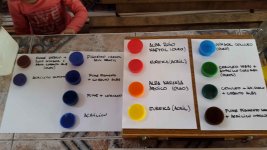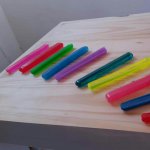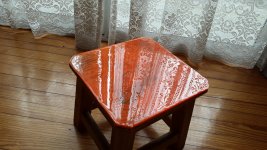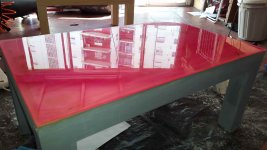I´ve some experience with epoxy resin, and decided to apply that experience in cabinet making.
We will review the epoxy resin properties along with the applications
The first thing I planned to do was the vent tube of the speakers, here are the pics:
https://drive.google.com/file/d/0B4DGKAUwb_MKZldzWmNiTVlNRTg/view?usp=sharing
https://drive.google.com/file/d/0B4DGKAUwb_MKX1JMMWw4VnkycXM/view?usp=sharing
https://drive.google.com/file/d/0B4DGKAUwb_MKTFhQTDlNb2tKRGc/view?usp=sharing
https://drive.google.com/file/d/0B4DGKAUwb_MKRm1yTFVGVUo5ckU/view?usp=sharing
https://drive.google.com/file/d/0B4DGKAUwb_MKTFJYRy1oVnM5WGs/view?usp=sharing
https://drive.google.com/file/d/0B4DGKAUwb_MKbzRDZGMxcWJ2Rms/view?usp=sharing
https://drive.google.com/file/d/0B4DGKAUwb_MKWVFXLWZpQ3pidEU/view?usp=sharing
THE RESULTS
https://drive.google.com/file/d/0B4DGKAUwb_MKeDhpVFZocklxWkE/view?usp=sharing
https://drive.google.com/file/d/0B4DGKAUwb_MKNTRQbkZVdW9iRXc/view?usp=sharing
https://drive.google.com/file/d/0B4DGKAUwb_MKMk5zTlpOQWs5eWM/view?usp=sharing
https://drive.google.com/file/d/0B4DGKAUwb_MKU3Q2MFpDNWNoMjA/view?usp=sharing
https://drive.google.com/file/d/0B4DGKAUwb_MKd0VKbVp0OVlvcVU/view?usp=sharing
Then I routed the inner border, like this
https://drive.google.com/file/d/0B4DGKAUwb_MKNVJ1eU9XMXF5NDA/view?usp=sharing
https://drive.google.com/file/d/0B4DGKAUwb_MKa2ZlSW4yWHRWSVk/view?usp=sharing
And the FINAL EXTERIOR RESULT
https://drive.google.com/file/d/0B4DGKAUwb_MKUmQtaVZGa0FfLUU/view?usp=sharing
https://drive.google.com/file/d/0B4DGKAUwb_MKSE1qSFkySjB1cjQ/view?usp=sharing
We will review the epoxy resin properties along with the applications
The first thing I planned to do was the vent tube of the speakers, here are the pics:
https://drive.google.com/file/d/0B4DGKAUwb_MKZldzWmNiTVlNRTg/view?usp=sharing
https://drive.google.com/file/d/0B4DGKAUwb_MKX1JMMWw4VnkycXM/view?usp=sharing
https://drive.google.com/file/d/0B4DGKAUwb_MKTFhQTDlNb2tKRGc/view?usp=sharing
https://drive.google.com/file/d/0B4DGKAUwb_MKRm1yTFVGVUo5ckU/view?usp=sharing
https://drive.google.com/file/d/0B4DGKAUwb_MKTFJYRy1oVnM5WGs/view?usp=sharing
https://drive.google.com/file/d/0B4DGKAUwb_MKbzRDZGMxcWJ2Rms/view?usp=sharing
https://drive.google.com/file/d/0B4DGKAUwb_MKWVFXLWZpQ3pidEU/view?usp=sharing
THE RESULTS
https://drive.google.com/file/d/0B4DGKAUwb_MKeDhpVFZocklxWkE/view?usp=sharing
https://drive.google.com/file/d/0B4DGKAUwb_MKNTRQbkZVdW9iRXc/view?usp=sharing
https://drive.google.com/file/d/0B4DGKAUwb_MKMk5zTlpOQWs5eWM/view?usp=sharing
https://drive.google.com/file/d/0B4DGKAUwb_MKU3Q2MFpDNWNoMjA/view?usp=sharing
https://drive.google.com/file/d/0B4DGKAUwb_MKd0VKbVp0OVlvcVU/view?usp=sharing
Then I routed the inner border, like this
https://drive.google.com/file/d/0B4DGKAUwb_MKNVJ1eU9XMXF5NDA/view?usp=sharing
https://drive.google.com/file/d/0B4DGKAUwb_MKa2ZlSW4yWHRWSVk/view?usp=sharing
And the FINAL EXTERIOR RESULT
https://drive.google.com/file/d/0B4DGKAUwb_MKUmQtaVZGa0FfLUU/view?usp=sharing
https://drive.google.com/file/d/0B4DGKAUwb_MKSE1qSFkySjB1cjQ/view?usp=sharing
That was an interesting experiment, but there is a cleaner method. First you make a ring of wood that fits around your vent tube. The ring should be about 2cm thick or more, and extend the diameter of the port tube by 2cm or more. Glue the pipe into this ring (using ABS or PVC glue) with the end of the pipe flush with (equal to) one side of the ring. Next you glue this side (with the flush port tube) to the inside of your wood cabinet using a wood glue. Once the glue is dry you drill a hole (smaller than the port tube) thru the cabinet wall from the outside that will emerge within the port tube. Then you use a router with a flush trim bit to extend the port tube hole thru the cabinet. Finally you round over this thru-hole with a chamfer or roundover bit. This construction method is common in the USA and avoids that nasty epoxy!
New tip
Thanks Charlie, good tip. Althoug the epoxy is no cheap material, Ihad som at home, and used it that way. Actually it isn´t nasty, just some difficult and I agree your method is simpler.
I´ll try it next time.🙂
Thanks Charlie, good tip. Althoug the epoxy is no cheap material, Ihad som at home, and used it that way. Actually it isn´t nasty, just some difficult and I agree your method is simpler.
I´ll try it next time.🙂
I think Dr Geddes has given some considerable practical info on his experiences with waveguide fabrication from epoxy/fiberglass to casting - I think Urethane casting resins are his material of choice today
I would use advanced search by author gedlee and add casting, plastics, resin related terms
I would use advanced search by author gedlee and add casting, plastics, resin related terms
Yeap, you´re right. I´ve passed trough those more than 100 pages on the matter. Is quite interesting but info is some disperse. It´s clear to me Dr Geddes knows a lot on the matter.
I´m not a professional on making waveguides or vent tubes, but without a doubt can tell a couple of things on many materials and their use.
I won´t use ceramics to made de tube, although i can make an excellent tube with clay, perfectly smooth, because clay varies from batch to batch and is subject to a lot of variables. Also ceramics properties are interesting, but is not easily attached to a wooden speaker, really.
I think one of the best materials could be delrin/polypenco, but one must have a lathe and know how to use it. Other materials can enter this category.
Fiberglass, ABS, and many others are of use, no doubt.
But I think that the spirit here is to DIY, not to go industrial.
That is the reason I´ve posted that trick with the resin.
I´m not a professional on making waveguides or vent tubes, but without a doubt can tell a couple of things on many materials and their use.
I won´t use ceramics to made de tube, although i can make an excellent tube with clay, perfectly smooth, because clay varies from batch to batch and is subject to a lot of variables. Also ceramics properties are interesting, but is not easily attached to a wooden speaker, really.
I think one of the best materials could be delrin/polypenco, but one must have a lathe and know how to use it. Other materials can enter this category.
Fiberglass, ABS, and many others are of use, no doubt.
But I think that the spirit here is to DIY, not to go industrial.
That is the reason I´ve posted that trick with the resin.
- Status
- Not open for further replies.
- Home
- Design & Build
- Construction Tips
- Epoxy resin in cabinet making





